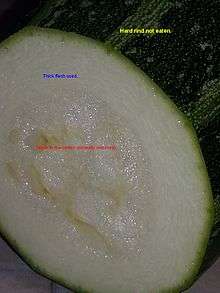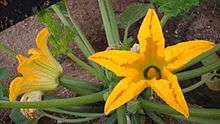Marrow (vegetable)
A marrow is a vegetable, the mature fruit of certain Cucurbita pepo cultivars. The immature fruit of the same or similar cultivars is called courgette (in Britain, Ireland, France, the Netherlands, Singapore, Malaysia and New Zealand) or zucchini (in North America, Australia, Czechia, Italy, Germany and Austria).[1] Like courgettes, marrows are oblong, green squash, but marrows have a firm rind and a neutral flavour ("overgrown when picked and insipid when cooked"),[1] making them useful as edible casings for mincemeat and other stuffings.[2] They can be stored for several weeks after harvest (like pumpkins and other winter squash), to be processed for food when required.[3] They are a vegetable used in Great Britain and areas with significant British influence, though their popularity is waning in favor of immature summer squash like courgette.[1]
 The thick flesh of a vegetable marrow is used in the UK. | |
| Type | Vegetable |
|---|---|
| Place of origin | United Kingdom |

Giant marrows are grown competitively in the United Kingdom[4] where the term "marrow" is often restricted to the striped, thick-skinned cultivar.[5][6]
In a culinary context, marrows are treated as a vegetable; usually cooked and presented as a savory dish or accompaniment. Botanically, marrows are fruit, a type of botanical berry, being the swollen ovary of the marrow flower. Marrows, like all squash, have their ancestry in the Americas.
History
According to the Oxford English Dictionary, the first mention of vegetable marrows dates to 1822,[7] zucchini to 1929,[8] and courgettes to 1931.[9] Before the introduction of Cucurbita species from the New World, marrow signified the immature, edible fruits of Lagenaria, a cucurbit gourd of African origin widely grown since Antiquity for eating when immature and for drying as watertight receptacles when grown to maturity.

Marrows are commonly cultivated in the British Isles, and the term "marrow" for the plant and for the fruit is current there, especially for the striped, thicker-skinned cultivar. However, both in North America (since the 1920s) and in Britain (since the 1960s), thinner-skinned immature marrows have gained popularity due to their tender skin and distinct flavour. Hedrick (1928) in his book The vegetables of New York p.50, describes the "English Vegetable Marrow" as "one of the earliest forms of marrow squash grown, but has never been exceedingly popular in this country".
The fashion for eating immature marrows, called in Britain "courgettes", is relatively recent in Britain. Sudell (1966)[10] does not mention courgettes, although he has a section on "vegetable marrow", noting both trailing (vining) and bush types and saying "cut when young". Witham Fogg (1966)[11] wrote "Courgettes These are really very tender baby marrows which have long been popular in France. ... Cooked and eaten with butter they form a very palatable dish." He devotes a page and a half to (vegetable) marrows and less than half a page to courgettes, which he clearly regards as something new to Britain.
The record for the world's largest marrow is currently being held by William Gibbs who grew his giant from an allotment in North West Leicestershire. It weighed a surprising 128 pounds. Gibbs was regarded as a master in his trade but retired from competing after only two years at his peak when his crop was sabotaged by a rival grower. He was not only able to grow the marrows out long but expanded girth by around 415mm from the previous year. Gibbs specialised in marrow growing before moving to the Gladioli (flower) section.
Nutrition
Marrows, like zucchini,[12] are low in food energy (approximately 71 kJ or 17 kcal per 100 g fresh marrow) and contain useful amounts of folate (24 μg/100 g), potassium (261 mg/100 g) and provitamin A (200 IU [10 RAE]/100 g).[13]
Toxicology
Members of the plant family Cucurbitacea, which includes zucchini, marrows, pumpkins and cucumbers, can contain toxins called cucurbitacins. These are chemically classified as steroids; they defend the plants from predators, and have a bitter taste to humans. Cultivated cucurbitaceae are bred for low levels of the toxin and are safe to eat. However, ornamental pumpkins can have high levels of cucurbitacins, and such ornamental plants can cross-fertilise edible cucurbitaceae – any such cross-fertilised seeds used by the gardener for growing food in the following season can therefore potentially produce bitter and toxic fruit. Also, dry weather conditions or irregular watering can stress the plant and favour the production of the toxin, which is not destroyed by cooking.[14][15]
In August 2015, a 79-year-old German man and his wife ate a marrow grown by a neighbour. The couple noted the unusually bitter taste. Shortly afterwards they were both admitted to a Heidenheim hospital, apparently with symptoms of a gastrointestinal infection. The woman, who had eaten a smaller portion, survived, while the man died. Toxicological analysis of the meal confirmed the presence of cucurbitacin.[16]
References
- Dr. D.G. Hessayon (2009). The Vegetable and Herb Expert. London: Expert Books.
- Slater, Nigel. "Nigel Slater's marrow recipes". The Guardian. Retrieved 13 October 2015.
- Marrows - Grow Your Own Info
- Woledge, Stuart (14 August 2013). "Grandfather grows massive marrow which is heavier than a baby HIPPO in just five weeks". The Daily Mail. Retrieved 12 October 2015.
- Austin, Gareth (23 July 2010). "BBC Dig In blog". Dig In Blog. BBC. Retrieved 11 April 2016.
Courgettes are commonly described as marrows harvested young. However, there are some slight horticultural differences between courgettes and marrows. Courgettes [Courgette plants] tend to be bushy and [have] thin-skinned [fruit], whereas marrows [marrow plants] tend to trailing and have [fruits with] a thicker skin.
- "The Gardener's Almanac, entry at "Marrow"". Retrieved 11 April 2016.
The general difference between Marrows and Courgettes/Zuchini is; Marrow plants tend to trail out and the fruit skin is quite thick, whereas Courgettes grow as a bush and the skins are quite thin.
- Sabine, J. (1822). "A description and account of the cultivation of a variety of gourd called vegetable marrow". Trans. Hort. Soc. 2: 255.
- Sunset. 58 (2). 1822. Missing or empty
|title=(help) - Lucas, E. (1931). Vegetable Cookery. 266. Missing or empty
|title=(help) - Sudell, Richard (1966), Practical Gardening in Pictures, London: Oldhams Books, p. 207, OCLC 220388288
- Witham Fogg, H.G. (1966), Vegetables All the Year Round, London: Stanley Paul, p. 105, OCLC 7404259
- Percy Russell & Anita Williams (January 1995). The Nutrition and Health Dictionary. pp. 473–474. ISBN 9780412989919.
- USDA Agricultural Research Service National Nutrient Database Basic Report: 11477, Squash, summer, zucchini, includes skin, raw
- "Poisonous courgette warning". Retrieved 12 October 2015.
- "Auf den Geschmack kommt es an [Taste matters]". Retrieved 24 August 2015.
- "Mann stirbt an Garten Zucchini [Man dies of garden marrow]". Retrieved 24 August 2015.
External links
- . Encyclopædia Britannica (11th ed.). 1911.
